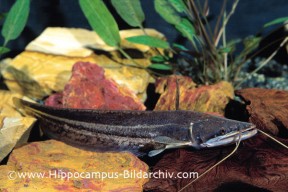Wallago attu
Helicopter Catfish
Classification
Siluridae
Distribution
Widely distributed throughout much of Asia. It has been recorded in Afghanistan, Pakistan, India, Nepal, Bangladesh, Sri Lanka, Myanmar, China, Thailand, Laos, Cambodia, Vietnam, Indonesia and Malaysia.
Habitat
Prefers turbid, deep slow-moving or still bodies of water such as large lakes and rivers. It tends to hide in muddy areas, often hiding around river banks. It breeds in shallow water just prior to the wet season, before migrating to flooded areas to feed.
Maximum Standard Length
96″ (240cm)! Most specimens do not attain this size, but assume 48″ (120cm) as a minimum adult size.
Aquarium SizeTop ↑
An adult fish would require a truly enormous aquarium or better still, pond. Minimum size would be something in the region of 144″ x 48″ x 48″ (260cm x 120cm x 120cm) – 5500 litres. Even this may not be large enough for an old fish.
Maintenance
Decor is not critical, and would most likely be destroyed or continually buffeted around at any rate, so a bare tank, perhaps with a gravel substrate is probably best. This kind of fish requires a massive, highly efficient filtration system to deal with the large amounts of waste it produces. Regular partial water changes are also needed. The tank should have a very heavy, tightly fitting cover to prevent the fish escaping.
Water Conditions
Temperature: 66-84°F (19-29°C).
pH: 6.0-7.6
Hardness: 1-20°H
Diet
Highly piscivorous, although wild specimens have been found with amphibians, birds, small mammals and even human remains in their stomachs! In the aquarium small specimens can be offered white fish such as lancefish, earthworms, and prawns. Larger specimens will accept whole trout and the like, but do not need to be fed as often. Once or twice a week is more than adequate. Extreme caution must be exercised when feeding this fish, as it will often launch itself from the water, and is more than capable of causing injury (see below).
Behaviour and CompatibilityTop ↑
Should be kept alone as a single specimen as it will consume any fish it can fit in its capacious mouth, and will usually kill anything it can’t.
Sexual Dimorphism
Unknown.
Reproduction
Not achieved in aquaria for obvious reasons, but has been bred commercially in ponds in Malaysia.
NotesTop ↑
This species is clearly not an aquarium fish, and thankfully is not imported with any great regularity. Young specimens are occasionally seen for sale however and no matter how cute they look, don’t be tempted to buy one. The gigantic adult size is not the only problem with W. attu, as the mouth is filled with needle sharp, backward-pointing teeth. The fish will bite aggressively when being fed, especially when handled and larger individuals could easily sever a hand or worse. It is a genuinely dangerous fish to own, and should only be considered by the most experienced aquarist with the resources required to house it properly.




